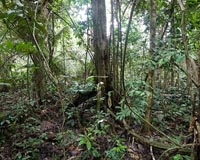| . |  |
. |
Basque Country, Spain (SPX) Jan 21, 2010 A team from the Department of Plant Biology and Ecology at the University of the Basque Country (UPV/EHU) are focusing their research on the study of the ecology of rivers. The person in charge is Mr Jes�s Pozo. For more than twenty years this team has been trying to identify links between the ecology and functioning of rivers and the surrounding terrestrial environment because, when all is said and done, rivers are like the excretory apparatus of the continents, just like the kidney is to the human body. River water often reflect the state of health of the external environment. Within this line of research, the UPV/EHU team is focusing on studying the possible impact of the afforestation of exotic species on the functioning of rivers, both on the chemistry of the water as well as on the communities of organisms therein. An exotic species is a species introduced outside its normal area of distribution, for example, the eucalyptus - the case in hand. Rivers of any specific geographical environment have a natural riverside type of vegetation and the community of organisms in the river is accustomed to consuming the dead leaves and foliage that enter the water from this surrounding vegetation. When this natural vegetation (in this case deciduous woods) are substituted by exotic plantations the quality of this plant material changes and the community of river organisms have to deal with the use or otherwise of this non-autochthonous organic material. This use or not by the aquatic organisms of the new material entering the river system can have certain repercussions, both on the organisms themselves and on processes occurring in the river. Until recently the methods on which the diagnosis of masses of water were based were structural ones, i.e. the study, for example, of the presence or otherwise of certain organisms were taken as indicators of better or worse quality of a river. Recently, however, attempts are being made to take into account not only the structure, i.e. the organisms that are there and not there, but also what the organisms that exist do, that is, if the river processes function in a suitable manner. In relation to the tendency that exists of examining the processes when evaluating the ecological state of the rivers, the team at the UPV/EHU focused principally on the decomposition of dead leaves and foliage. Their goal was to evaluate the ecological state of the river water based on the response of a process, in this case the decomposition of the dead leaves, to various kinds of impact.
Eucalyptus vs deciduous species The eucalyptus is a species that loses more leaves in the summer; in other words, most of the energy that can enter the river ecosystem from a eucalyptus plantation does so at this time of the year. It coincides with the period when the rivers are at their lowest level and, as a result, a large amount of this material stays in the rivers. Theoretically the organisms would have a greater amount of material to consume. Nevertheless, certain studies have shown that the dead vegetation from eucalyptus has a number of toxic products (polyphenols) that can have negative effects on the development of some organisms. In any case the dead leaves rapidly lose these toxic compounds once in the water and so, according to the studies carried out, after the passing of a certain period of time, the eucalyptus material decomposes and used in the same manner as other material. The UPV/EHU team also evaluated the quantity of material entering the rivers from eucalyptus populations which are interspersed with deciduous woods (those losing their foliage in the autumn). They observed that more material entered the rivers that go through deciduous forests. But, is this material consumed? The fact is that the dead vegetation from deciduous trees enters the rivers at a period when their levels are at their highest and a considerable part of this material is simply carried away downriver; most of the eucalyptus material, on the other hand, being produced in the summer, is retained in the rivers due to the low water levels. Thus, despite dead leaves from the eucalyptus having fewer problems of initial decomposition, i.e. less consumption for the organisms until the phenolic components are eliminated, the research team concluded that this material tends to be used in rivers as much as that from deciduous trees.
Share This Article With Planet Earth
Related Links Basque Research Forestry News - Global and Local News, Science and Application
 Seeing The Forest Through The Trees And Seeing The Trees Through The Leaves
Seeing The Forest Through The Trees And Seeing The Trees Through The LeavesWashington DC (SPX) Jan 21, 2010 Since the time of the earliest humans, people have attempted to understand the natural environment. We have observed our surroundings and searched for explanations for natural phenomena. Yet despite our persistence over thousands of years, many basic questions remain to be answered. Although we understand core processes such as photosynthesis, we do not have a full understanding of issues such ... read more |
|
| The content herein, unless otherwise known to be public domain, are Copyright 1995-2009 - SpaceDaily. AFP and UPI Wire Stories are copyright Agence France-Presse and United Press International. ESA Portal Reports are copyright European Space Agency. All NASA sourced material is public domain. Additional copyrights may apply in whole or part to other bona fide parties. Advertising does not imply endorsement,agreement or approval of any opinions, statements or information provided by SpaceDaily on any Web page published or hosted by SpaceDaily. Privacy Statement |